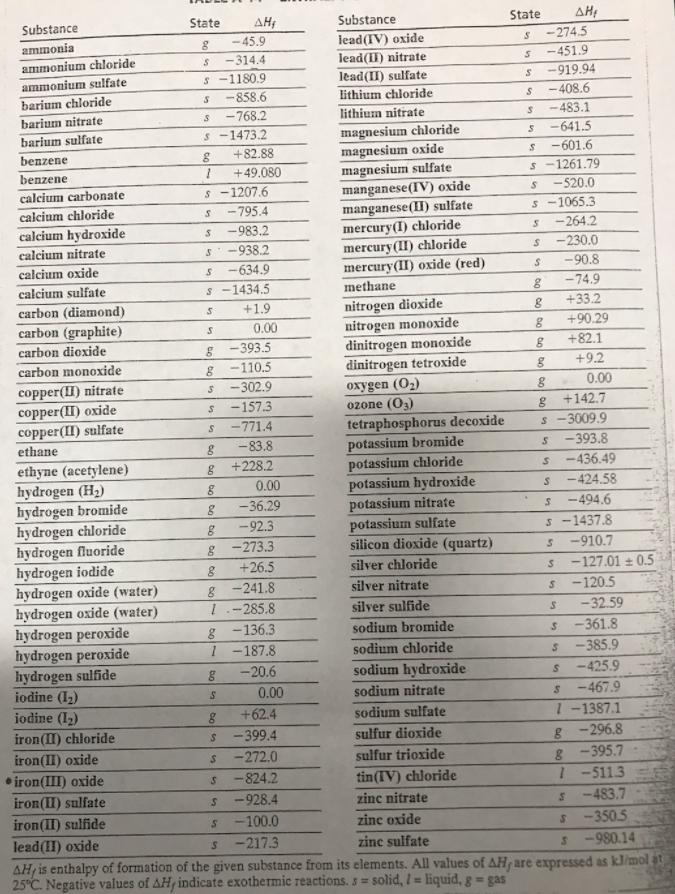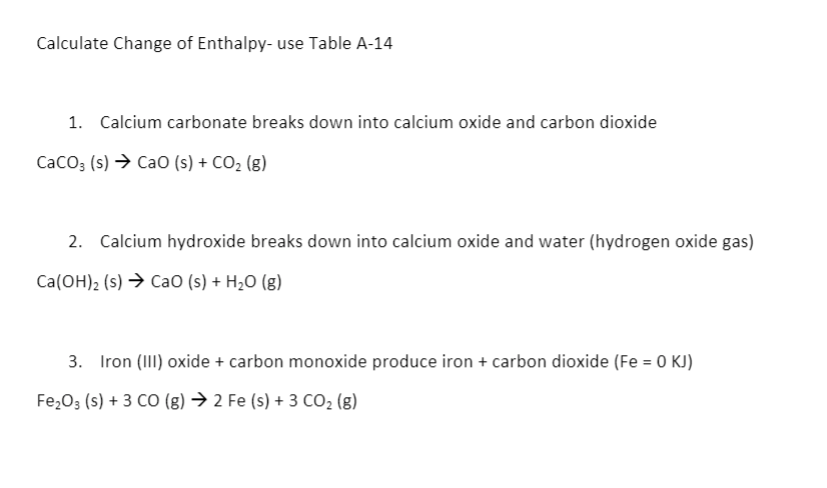Chemistry: Principles and Practice
3rd Edition
ISBN:9780534420123
Author:Daniel L. Reger, Scott R. Goode, David W. Ball, Edward Mercer
Publisher:Daniel L. Reger, Scott R. Goode, David W. Ball, Edward Mercer
Chapter5: Thermochemistry
Section: Chapter Questions
Problem 5.84QE
Related questions
Question
3

Transcribed Image Text:Substance
State
AHs
Substance
State
ΔΗ
-45.9
-274.5
lead(IV) oxide
lead(II) nitrate
lead(II) sulfate
ammonia
ammonium chloride
-314.4
-451.9
ammonium sulfate
s -1180.9
-919.94
barium chloride
-858.6
lithium chloride
- 408.6
-483.1
-641.5
barium nitrate
-768.2
lithium nitrate
-1473.2
magnesium chloride
magnesium oxide
magnesium sulfate
manganese(IV) oxide
manganese(II) sulfate
mercury(I) chloride
mercury(II) chloride
mercury(II) oxide (red)
barium sulfate
benzene
+82.88
-601.6
benzene
+49.080
1261.79
calcium carbonate
s -1207.6
-520.0
calcium chloride
-795.4
s -1065.3
calcium hydroxide
-983.2
-264.2
calcium nitrate
-938.2
-230.0
calcium oxide
–634.9
-90.8
calcium sulfate
carbon (diamond)
carbon (graphite)
-1434.5
methane
-74.9
nitrogen dioxide
nitrogen monoxide
dinitrogen monoxide
dinitrogen tetroxide
+1.9
+33.2
0.00
+90.29
carbon diexide
-393.5
+82.1
carbon monoxide
-110.5
+9.2
copper(II) nitrate
copper(II) oxide
-302.9
oxygen (O2)
ozone (O3)
0.00
-157.3
+142.7
copper(II) sulfate
ethane
tetraphosphorus decoxide
potassium bromide
potassium chloride
potassium hydroxide
potassium nitrate
potassium sulfate
silicon dioxide (quartz)
-771.4
s -3009.9
- 393.8
-436.49
-83.8
ethyne (acetylene)
hydrogen (H2)
hydrogen bromide
hydrogen chloride
hydrogen fluoride
hydrogen iodide
hydrogen oxide (water)
hydrogen oxide (water)
hydrogen peroxide
hydrogen peroxide
hydrogen sulfide
iodine (I2)
+228.2
0.00
- 424.58
- 36.29
-494.6
-92.3
s -1437.8
-910.7
-273.3
+26.5
-241.8
silver chloride
-127.01 ± 0.5
silver nitrate
-120.5
1.-285.8
silver sulfide
-32.59
8 -136.3
1 -187.8
sodium bromide
-361.8
sodium chloride
sodium hydroxide
s - 385.9
-425.9
-20.6
0.00
sodium nitrate
-467.9
iodine (I2)
iron(I) chloride
+62.4
sodium sulfate
1 -1387.1
8 -296.8
8 -395.7
-399.4
sulfur dioxide
iron(II) oxide
-272.0
sulfur trioxide
-824.2
iron(III) oxide
iron(II) sulfate
tin(IV) chloride
1-511.3
-928.4
zinc nitrate
-483.7
iron(II) sulfide
lead(II) oxide
AH is enthalpy of formation of the given substance from its elements. All values of AH are expressed as klimol at
25°C. Negative values of AH indicate exothermic reactions. s= solid, 1 = liquid, g = gas
-100.0
zinc oxide
-350.5
-217.3
zinc sulfate
-980.14

Transcribed Image Text:Calculate Change of Enthalpy- use Table A-14
1. Calcium carbonate breaks down into calcium oxide and carbon dioxide
CacO3 (s) → CaO (s) + CO2 (g)
2. Calcium hydroxide breaks down into calcium oxide and water (hydrogen oxide gas)
Ca(OH)2 (s) → CaO (s) + H2O (g)
3. Iron (III) oxide + carbon monoxide produce iron + carbon dioxide (Fe = 0 KJ)
Fe203 (s) + 3 CO (g) → 2 Fe (s) + 3 CO2 (g)
Expert Solution
This question has been solved!
Explore an expertly crafted, step-by-step solution for a thorough understanding of key concepts.
Step by step
Solved in 2 steps with 1 images

Knowledge Booster
Learn more about
Need a deep-dive on the concept behind this application? Look no further. Learn more about this topic, chemistry and related others by exploring similar questions and additional content below.Recommended textbooks for you

Chemistry: Principles and Practice
Chemistry
ISBN:
9780534420123
Author:
Daniel L. Reger, Scott R. Goode, David W. Ball, Edward Mercer
Publisher:
Cengage Learning

Chemistry & Chemical Reactivity
Chemistry
ISBN:
9781337399074
Author:
John C. Kotz, Paul M. Treichel, John Townsend, David Treichel
Publisher:
Cengage Learning

Chemistry & Chemical Reactivity
Chemistry
ISBN:
9781133949640
Author:
John C. Kotz, Paul M. Treichel, John Townsend, David Treichel
Publisher:
Cengage Learning

Chemistry: Principles and Practice
Chemistry
ISBN:
9780534420123
Author:
Daniel L. Reger, Scott R. Goode, David W. Ball, Edward Mercer
Publisher:
Cengage Learning

Chemistry & Chemical Reactivity
Chemistry
ISBN:
9781337399074
Author:
John C. Kotz, Paul M. Treichel, John Townsend, David Treichel
Publisher:
Cengage Learning

Chemistry & Chemical Reactivity
Chemistry
ISBN:
9781133949640
Author:
John C. Kotz, Paul M. Treichel, John Townsend, David Treichel
Publisher:
Cengage Learning

General Chemistry - Standalone book (MindTap Cour…
Chemistry
ISBN:
9781305580343
Author:
Steven D. Gammon, Ebbing, Darrell Ebbing, Steven D., Darrell; Gammon, Darrell Ebbing; Steven D. Gammon, Darrell D.; Gammon, Ebbing; Steven D. Gammon; Darrell
Publisher:
Cengage Learning

Chemistry: The Molecular Science
Chemistry
ISBN:
9781285199047
Author:
John W. Moore, Conrad L. Stanitski
Publisher:
Cengage Learning

Chemistry: Matter and Change
Chemistry
ISBN:
9780078746376
Author:
Dinah Zike, Laurel Dingrando, Nicholas Hainen, Cheryl Wistrom
Publisher:
Glencoe/McGraw-Hill School Pub Co